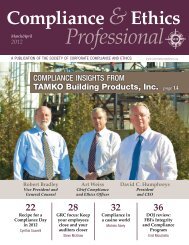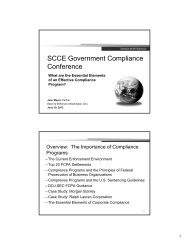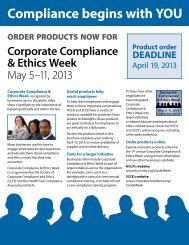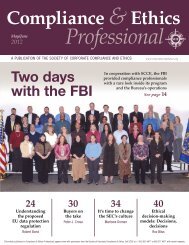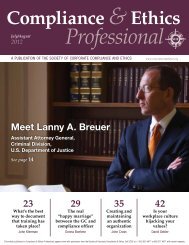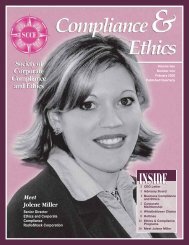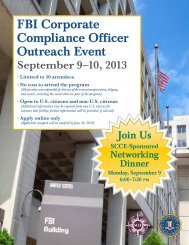Compliance &Ethics - Society of Corporate Compliance and Ethics
Compliance &Ethics - Society of Corporate Compliance and Ethics
Compliance &Ethics - Society of Corporate Compliance and Ethics
- No tags were found...
You also want an ePaper? Increase the reach of your titles
YUMPU automatically turns print PDFs into web optimized ePapers that Google loves.
y Frank J. NavranYou can’t cure symptoms»»Finding the underlying problem first may avert a catastrophe later.»»Diagnostic interviews, focus groups, <strong>and</strong> surveys will help you uncover the root cause <strong>of</strong> organizational problems.»»Build a rapport <strong>and</strong> an atmosphere <strong>of</strong> trust before you start asking the tough questions.»»A document review will give you insights into what employees learn about the formally stated st<strong>and</strong>ards for employee conduct.»»Skills, knowledge, <strong>and</strong> conceptual models can only take us so far in solving the organizational problems we face.NavranIwas 16, <strong>and</strong> over the summer <strong>of</strong> 1959 hadmanaged to accumulate $150 (not bad consideringthat minimum wage was $.50/hr.that year). My dream was about to come true:a car <strong>of</strong> my own. I narrowed my choice downto two options. One was a drab, 1952 Plymouthfour-door sedan. It was owned by afamily friend <strong>and</strong> I knew it to be reliable—deadlydull, but reliable. Theother was a 1953 Dodge convertiblewith the first generation hemi V-8.Very cool! And, they were the sameprice, $100. Naturally, with teenagepassion overriding logic, I boughtthe Dodge.Two weeks into my ownership experience,my car was no longer able to go up hills.The push to the local garage <strong>and</strong> a compressiontest revealed burnt valves. My buddyDick <strong>and</strong> I decided to tackle the valve jobourselves. How hard could it be? For the nextthree months, we were fully occupied withdismantling the engine, having the valvesground <strong>and</strong> seated <strong>and</strong> reassembling my pride<strong>and</strong> joy. The ensuing satisfaction in a job welldone lasted approximately 18 miles beforethe engine gave up the ghost for good.It seems burnt valves are a symptom. Inthis case they were symptomatic <strong>of</strong> a failed oilpump. I’d “cured” the symptom but I had failedto recognize or address the underlying problem.The junkman gave me $12 for the car <strong>and</strong> lifetaught me one <strong>of</strong> the most important lessonsI would ever learn. It is a lesson every firstyearmedical student learns <strong>and</strong> continues torelearn. Prescription without diagnosis is malpractice.If you treat symptoms, you may mask theunderlying causes <strong>of</strong> the initial problem untilthey manifest themselves as a subsequent, <strong>and</strong>typically more substantive, problem. If all youare doing is polishing the valves in an enginethat does not circulate oil, catastrophe awaits.As someone who has been consulting onorganizational ethics <strong>and</strong> leadership issuessince the late 1970s, I can tell you firsth<strong>and</strong>that diagnosis remains the single most importantstep in addressing any problem in anyorganization. Period! Full stop!So, what does organizational diagnosislook like? How do we identify underlyingcauses behind observed problems? And,why ought this matter to you? How does thisimpact your role regarding ethical management<strong>and</strong> leadership in your organization?<strong>Compliance</strong> & <strong>Ethics</strong> Pr<strong>of</strong>essional May/June 2013+1 952 933 4977 or 888 277 4977 www.corporatecompliance.org 55






